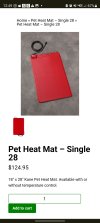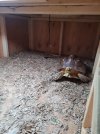@AshleeSparling
Why are there three probes? You only need one thermostat.
All three probes are right under your CHEs. They should be over to the far side of the enclosure away from the CHEs.
You are losing a tremendous amount of the electric heat that you are generating by having the heat outside the enclosure. Much of the heat is dissipating into the room, and the heat the does make it inside rises up and out due to the chimney effect.
This tortoise is too large for CHEs and heat lamps. Those will burn the carapace if they are close enough to be effective. Its time for a new strategy. I would recommend a Kane mat under a large RHP. Set both on the same thermostat and put the probe over on ether other side of the enclosure. You'll have to make a raised platform for the Kane mat to keep the substrate off of it. Put these inside the enclosure and close up the holes on the top.
Why are there three probes? You only need one thermostat.
All three probes are right under your CHEs. They should be over to the far side of the enclosure away from the CHEs.
You are losing a tremendous amount of the electric heat that you are generating by having the heat outside the enclosure. Much of the heat is dissipating into the room, and the heat the does make it inside rises up and out due to the chimney effect.
This tortoise is too large for CHEs and heat lamps. Those will burn the carapace if they are close enough to be effective. Its time for a new strategy. I would recommend a Kane mat under a large RHP. Set both on the same thermostat and put the probe over on ether other side of the enclosure. You'll have to make a raised platform for the Kane mat to keep the substrate off of it. Put these inside the enclosure and close up the holes on the top.



